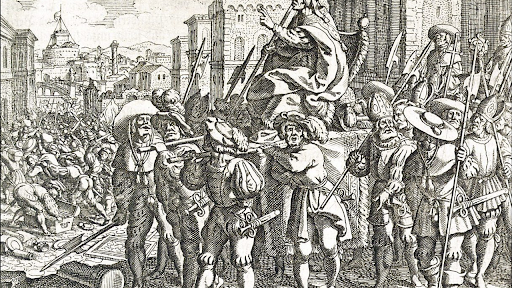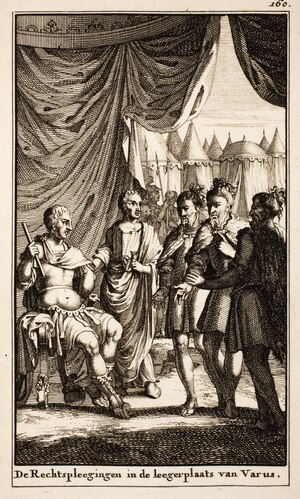During the 15th-16th century armed conflict flared up with regular intervals. Whether this included the full-scale, royal armies or smaller skirmishes between minor lords, there was a constant demand for soldiers. The Burgundian Wars (1474-77) made one thing clear: the traditional armed forces made up of a medley of lords, foreign mercenaries and local farmers were no match against fully organized units of mercenaries. Whereas the former group was divided by both social status and varying goals, the semi-professional mercenaries had a single purpose which made them all the more deadly.
Hitherto, the princes of Europe had looked to Swiss bands of mercenaries for their soldiering needs. However, the Swiss found themselves with a new competitor when Maximilian I of the Holy Roman Empire created the first regiments of what would later become known as the landsknechts. The recruits were almost exclusively German-born men of varying backgrounds - some were farmers' sons, others were criminals.
 |
| German illustration of landsknechts, ca 1530 - note their very flamboyant clothing |
Initially, Maximillian had intended the new force to be at his beck and call - and truthfully, they continued to serve both him and several succeeding Holy Roman Emperors. However, the landsknechts quickly realised that there was money to be made from their specific métier. Consequently they began selling their services to various monarchs. The result was that there were very few conflicts in the 16th century that the landsknechts were not involved in.
Amongst others, they were involved in Charles V's defense of Vienna from the Ottomans and were quickly employed by the French as well, particularly in the Wars of Religion (1562-98). Further south, their services were used in the Italian Wars (1494-1559). They were also employed by the rulers of Denmark, Poland, Hesse and Sweden - even Henry VIII used them briefly during his attack on France. It was not merely for interstate conflict that they were used. Edward Seymour, Lord Protector of England during the minority of Edward VI brought in a smaller band of them to defeat the Ket Rebellion in 1549.
In order for a young man to become a landsknecht, he would have to pass certain criteria. At first, he would have to present himself to the captain of the regiment he wished to join. He was required to bring a suitable weapon with him - usually this would be the traditional pike which cost around 1 guilder. He would then be subjected to rather superficial physical tests including jumping over a certain obstacle. If he succeeded, he would be accepted into their ranks.
| A landsknecht with a two-handed sword |
One of the most infamous episodes relating to the landsknechts was the sack of Rome in 1527. Charles V - another Holy Roman Emperor - found himself in an (armed) argument with the pope. The emperor had failed to pay his mercenaries which led them to desert and enter the Eternal City; they spent the next nine months wreaking havoc. Looting, raping and killing were widespread as the papal forces were unable to stop them. However, if Charles V thought he had complete control over his mercenaries, he was sorely mistaken. The Germans - about 14.000 in number and 6.000 Spaniards - had not been paid for months and were reluctant to leave a city where they could take whatever they wanted by force.
 |
| The sack of Rome, 1527 |
Naturally, such behaviour was bound to give the mercenaries a certain reputation but this could be said for any group of mercenaries or even soldiers in general. Landsknechts were quickly purported to be rather hotheaded and it was not uncommon for them to fight amongst themselves when off the battlefield. Gambling and drinking - both traditionally popular in garrisons - were also a fairly typical aspect of their lives. Outwardly, they got a reputation for rather flamboyant looks with wide-brimmed, feathered hats and clothing in bright colours.
On occasion, they would get into trouble with the local authorities. For instance, two landsknechts were charged with the public murder of a man in 1572 (the victim's name is unknown). On another occasion, a landsknecht was charged with murdering a fellow landsknecht with a hoe during a brawl in 1577.
However, when they were in their regiments, discipline was not lacking. Their captains made sure that their men did not run riot and it was not uncommon for regiments to deal with disciplinary matters amongst themselves. Trials for offenders would be conducted with the men of the regiment taking an active part. In some regiments, the captain would represent the accused.
 |
| Trial in a landsknecht regiment |
The irregular payment of wages remained a sore point for the landsknechts for years to come. Increasingly disillusioned with the unstable source of income, more and more soldiers deserted and formed their own bands or joined other sovereigns with a more generous nature.
It became more common for regiments of landsknechts to be led by their own captain. He would be personally contracted by i.e. a king and would be in charge of training and organizing the men under his command. A landsknecht could earn four guilders each month which was a very attractive salary - especially when compared to what other trades could offer. However, each man had to pay for their own weapons and armour - consequently, the quality (and quantity) of both his protective gear and offensive weaponry depended on his purse.
The majority of landsknechts had pikes as their main weapons. On the battlefield they would organize into a phalanx supported by men armed with arquebuses - the very best soldiers were armed with the large swords which required two hands to wield properly.
Besides the wage of 4 guilders per month, there were other ways of accruing more income. Those soldiers who displayed particular bravery - and survived the battle - could be rewarded with double pay. Of course, there was always the opportunity for plunder.
It was alleged that the southern German and the Swiss landsknechts were particularly brutal. In France (around 1500) it was said that "a landsknecht thrown out of heaven could not get into hell because he frightened the devil". In their turn, the Romans who had been subjected to the unwelcome presence of the landsknechts in 1527 claimed that not even the Turks could have committed such cruelty. Others agreed that while there was brutality in their behaviour, the landsknechts were far more prone to vandalism and looting than inventive torture methods.
 |
| A landsknecht of the more affluent kind - he has both sword, pike and the characteristically flamboyant clothing |
Captains of landsknechts could be remarkably well-educated. In an age with widespread illiteracy, some captains were able to read and write. One such was Captain Schärtlin whose soldiers participated in the sack of Rome in 1527. He wrote of his and his men's entry into Rome: "Great grief amongst them (the Romans) and much weeping. We all became rich".
Eventually, landsknechts faded into smaller regiments or bands and would later disappear completely. Professional soldiers who served their own king became more common in the 17th century and by then the landsknechts were confined to the pages of history.
